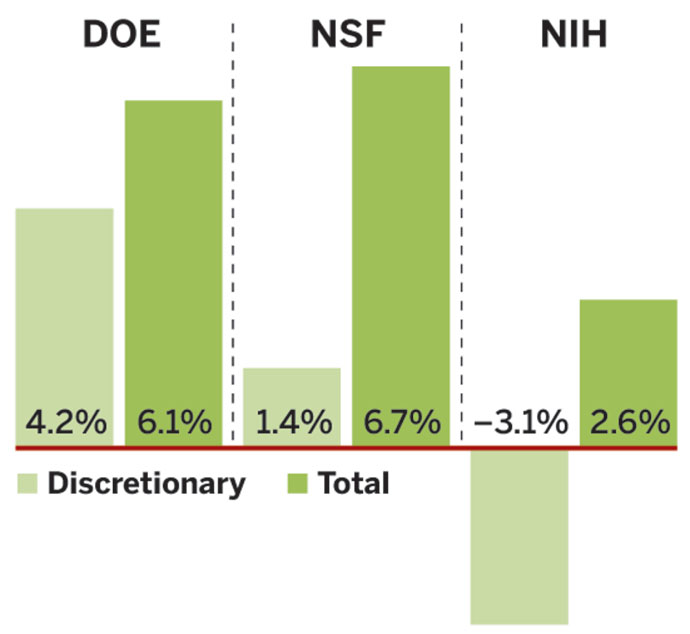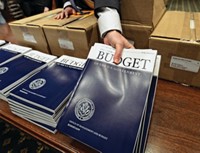Advertisement
Grab your lab coat. Let's get started
Welcome!
Welcome!
Create an account below to get 6 C&EN articles per month, receive newsletters and more - all free.
It seems this is your first time logging in online. Please enter the following information to continue.
As an ACS member you automatically get access to this site. All we need is few more details to create your reading experience.
Not you? Sign in with a different account.
Not you? Sign in with a different account.
ERROR 1
ERROR 1
ERROR 2
ERROR 2
ERROR 2
ERROR 2
ERROR 2
Password and Confirm password must match.
If you have an ACS member number, please enter it here so we can link this account to your membership. (optional)
ERROR 2
ACS values your privacy. By submitting your information, you are gaining access to C&EN and subscribing to our weekly newsletter. We use the information you provide to make your reading experience better, and we will never sell your data to third party members.
Policy
Obama’s Proposed R&D Budget Would Give Science A Boost
White House seeks more 2016 funding for nearly all research organizations
by Government & Policy Department
February 16, 2015
| A version of this story appeared in
Volume 93, Issue 7

In his opening bid to the Republican majority leading the 114th Congress, President Barack Obama proposed a fiscal 2016 budget calling for ambitious spending increases for science and technology.
But the annual request for discretionary funds, delivered to Capitol Hill on Feb. 2, was largely considered dead on arrival, critics contend. Instead, it’s widely viewed as a reflection of the President’s priorities for his last two years in office.
Overall, the White House is seeking a 6% increase for federal R&D funding to $146 billion in 2016, a significant increase with inflation expected to be under 2%. However, Obama’s proposal for basic research would rise by less than 3% to $32.7 billion, in line with his request for 2015, which was nearly flat for all research programs. For example, the Department of Defense would see its basic research funding cut by 8% in 2016 despite receiving an increase in overall R&D funding.
The President’s request is heavily tilted toward applied programs, such as climate change, public health, and advanced manufacturing, says Michael S. Lubell, director of public affairs at the American Physical Society. Total applied research would receive a 4% increase to $34.1 billion. “To some degree it is a replay of last year, although the numbers start off higher,” Lubell adds.
In a controversial move, the $4.0 trillion budget proposal rolls back cuts from sequestration, a budget cap that resulted in across-the-board cuts starting in the second half of 2013. Designed to chop $1.0 trillion in discretionary spending over 10 years, the sequester sets large-scale budget caps, and Congress is free to move money around within them.
Obama says he wants to put an end to this “mindless austerity” and is calling for an increase in spending for domestic programs.
“These numbers, as a package, probably don’t really work unless Congress acts to raise the discretionary spending cap,” says Matt Hourihan, director of the American Association for the Advancement of Science’s R&D Budget & Policy Program. “I think it may be a tough sell in this Congress to go as far as the President would like.”
Obama’s spending plan would boost R&D science funding across almost all research agencies. For example, the Department of Defense, the largest U.S. funder of science, would receive an increase of 7% to $72.1 billion in 2016. Likewise, the Department of Energy would receive a bump of 7% to $12.6 billion. The National Institutes of Health would receive a 3% total budget increase to $31.3 billion. And the National Science Foundation would receive a 5% increase to $6.3 billion.
Two new public health initiatives emerge in the President’s proposal. The budget includes $215 million to create a precision medicine program that Obama introduced in his State of the Union address. It also includes $1.2 billion spread across multiple agencies for combating antibiotic-resistant bacteria—nearly double the federal funds allotted in 2015.
Manufacturing continues to be a priority. For example, at the National Institute of Standards & Technology—a program creating partnerships among industry, academia, and government to study important manufacturing challenges—would receive $150 million under the budget plan.
Republicans who control Congress have their own ideas for shaping the nation’s spending, and they will make decisions on federal allocations in fiscal 2016 through their control of the appropriations process. But their spending bills will need Obama’s signature to become law.
Jump to Topics:
- National Institutes Of Health
- Department Of Energy
- National Science Foundation
It has been years since a divided Congress has been able to reach bipartisan agreement on a budget through the normal legislative process. But if all goes according to schedule now that both chambers are controlled by the GOP, the bills would be signed by the President no later than Sept. 30, the last day of fiscal 2015.—Jessica Morrison
President Obama’s plan wouldn’t give NIH the sizable 7% budget increase some other federal agencies might receive in 2016. But a 3% boost to $31.3 billion—a $1.0 billion increase over 2015 funding—far exceeds the meager increase he sought last year of 0.5%, well below the rate of inflation.
Several of the President’s major research initiatives focus squarely on NIH. Most prominent is the Precision Medicine Initiative, which aims to improve access to treatments tailored to individual patients. To accomplish that, scientists want to examine genetic, lifestyle, and biological data from 1 million volunteers. NIH would get a proposed $200 million for precision medicine in 2016. The agency plans to start with cancer research, the area in which personalized therapies are furthest along, and then expand to a bevy of other diseases.
Three other interagency efforts with presidential backing would give NIH substantial funding. It would get $100 million as part of an effort to curb the problem of antibiotic resistance. NIH’s part of the Brain Research through Advancing Neurotechnologies, or BRAIN, Initiative would receive $135 million, up $70 million from 2015. And its work on Alzheimer’s disease would get $50 million.
The budget request would also allow NIH to increase the number of competitive awards by just under 14% to 10,303 in 2016. If approved by Congress, the gain would be welcome news for the science community, which has been disturbed by the institute’s historically low funding rates.
As for the fate of individual institutes, the National Cancer Institute is asking for an almost 3% increase, up to $5.1 billion. And the National Institute of General Medical Sciences, which supports a great deal of chemistry research, also wants an almost 3% hike to $2.4 billion.—Andrea Widener
When he presented DOE’s $29.9 billion budget request, Secretary of Energy Ernest Moniz emphasized that the agency makes critical investments in chemistry, physics, climate, and other energy-related sciences. The DOE budget represents a 9% increase over the 2015 level for all programs, including an increase of 7% in science support for “the backbone of America’s research community,” Moniz says.
The Office of Science would get a proposed $5.3 billion to strengthen basic research, 5% above last year’s enacted level. This would allow DOE to continue to lead basic research in the physical sciences and strengthen the connection between advances in fundamental science and technology innovation, according to the agency.
The biggest Office of Science increases are for infrastructure at the agency’s national laboratories, up 43% to $113 million to support new construction and retrofits. The request for basic energy sciences, including chemistry and physics, is $1.9 billion, an almost 7% increase. However, the fusion energy science research program would take a hit of 10%, down to $420 million in the 2016 request. To show what consistent long-range support for science would look like, the budget includes projections for future Office of Science requests, increasing by $100 million each year to $5.7 billion in 2020.
Outside the Office of Science, DOE requests $10.4 billion for science and energy research, up almost 13% over the 2015 level of $9.1 billion. The energy efficiency and renewables research program request is up to $2.7 billion, an increase of 42% to support the Administration’s climate objectives. Finally, the Advanced Research Projects Agency—Energy, which develops cutting-edge technologies, received a 16% boost in requested funds to $325 million.
The overall DOE budget also includes $4.0 billion in new incentives to encourage states to make faster and deeper cuts to carbon dioxide emissions from power plants. The President’s plan calls for permanent extensions of the tax credits for solar and wind energy units to promote renewable energy sources.—Steven Gibb
Under President Obama’s proposal, NSF’s total budget would grow by 5% over last year’s funding level to $7.7 billion. But the Mathematical & Physical Sciences Directorate, which supports most of the agency’s chemistry research, wouldn’t see quite as much of a bump, with a proposed 2% increase over 2015 to $1.4 billion.
The Chemistry Division would get a slightly bigger boost, up 3% to $251 million. The largest increases would go to infrastructure projects, including an additional $1.5 million for major research instrumentation proposals.
Across NSF divisions, the greatest gains, more than 7%, are slated for the social sciences and the Office of International & Integrative Activities, which supports interdisciplinary and international research. Many of those programs are reflected in the agency’s new cross-disciplinary proposals, including its work on the interagency BRAIN Initiative, which would receive $144 million, up 35% from 2015. Research on the intersection of food, energy, and water would get $75 million in new funding, and work to examine the risk of and response to extreme events would receive a 190% increase to $58 million in 2016.
A smaller initiative would allow the agency to examine what works in efforts to increase diversity in the science workforce, says NSF Director France Córdova. The $15 million would allow NSF to examine its approach to diversity programs and to ensure that its endeavors to encourage the participation of women and minorities in science yield better results.
↑ Top
Jump to Topics:
- National Institutes Of Health
- Department Of Energy
- National Science Foundation
“How do we scale up all of the good efforts we’re doing?” Córdova asks. “The only way to do that is to look at it as a system.”—Andrea Widener








Join the conversation
Contact the reporter
Submit a Letter to the Editor for publication
Engage with us on Twitter